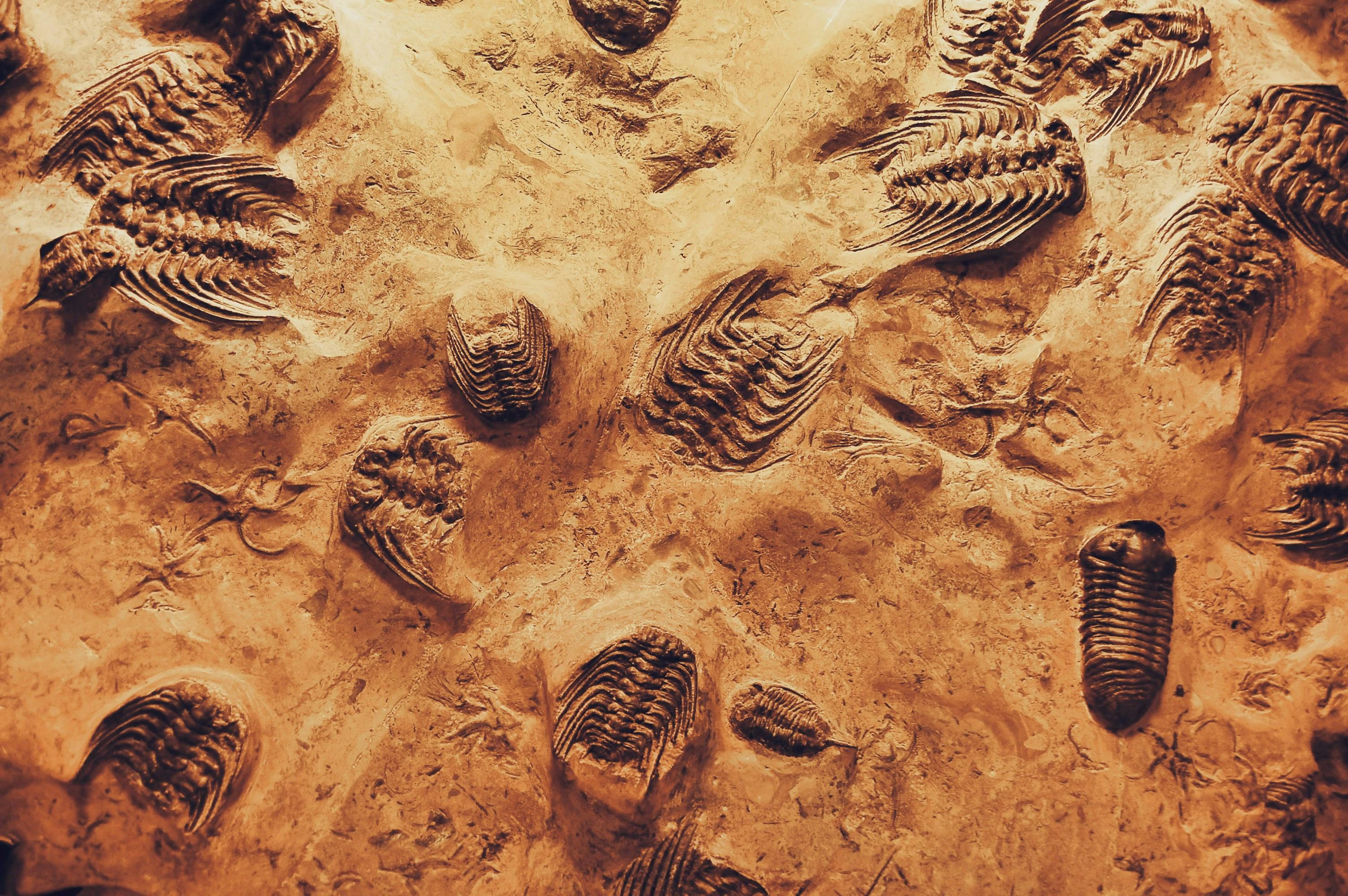Fossils for sale: personal finds in the Lorraine Muschelkalk.
1 . Introduction
The Muschelkalk (literally translated from German as “shell limestone” because of the large number of fossils it contains) is a subdivision of the Triassic period, which itself is the first subdivision of the Mesozoic (or secondary) era. Chronologically, the Triassic is preceded by the Permian (last period of the Paleozoic or Primary Era, at the end of which the greatest mass extinction occurred, causing the disappearance of 95% of marine species and 70% of terrestrial species). The Triassic was followed by the Jurassic and then the Cretaceous. These stages are well known thanks to their fossils
The Triassic period lasted from around 252 to 201 million years ago. It takes its name from the 3 eras that make it up in Germany:
- the Buntsandstein at the base corresponds to the sandstone deposits of a quasi-desert continent,
-the Muschelkalk corresponds to the limestone deposits of a shallow inland sea,
- the Keuper at the top corresponds to the marly deposits of a marshy continent from which the sea has retreated.
It's important to distinguish between the Germanic Triassic - which we're interested in here - and the Alpine Triassic. The latter, also divided into 3 periods, corresponds to a distinctly marine environment. The Muschelkalk corresponds to the Middle Triassic period and is made up of 3 levels: the Lower, Middle and Upper Muschelkalk. We are particularly interested in the Upper Muschelkalk, which dates from around -238.5 to -235 million years ago. There are many outcrops in our region, and it's only natural that we should offer for sale fossils we have collected ourselves.

In terms of stratigraphy, the base is made up of thick, almost marl-free limestone banks (entrock limestone), which are shallow-water deposits. Above, alternating marl and limestone banks (Ceratite limestone) correspond to deposits from a sea a few dozen meters deeper. This is, of course, a simplified description.
The limestone banks are the result of violent storms, whereas the marlstones were formed by sedimentation during calm periods. It is estimated that sea levels varied regularly during periods of transgression and regression lasting tens to hundreds of thousands of years.
The Muschelkalk Sea is an inland sea communicating with the immense Tethys Ocean through just two gates to the south-west and south-east. For this reason, its marine fauna is quite different from that of the Tethys and Panthalassa oceans. This sea extended over a large part of Germany and eastern France, particularly Lorraine.
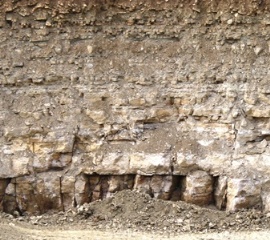
2 . Quarries and outcrops
To find fossils in Lorraine, but also wherever the Upper Muschelkalk outcrops, you can look in the fields, but that's not usually where you'll find quality fossils. They are often badly eroded or damaged by farm machinery. It's best to concentrate on areas where quarries or major works are being carried out. In Lorraine, several large quarries mine limestone from the Upper Muschelkalk. These are ideal places to find good-quality fossils that have been preserved from erosion, and to observe the stratigraphy. Other areas of interest include major construction projects such as the TGV EST high-speed train line, which crosses the Upper Muschelkalk over long distances, or the construction of industrial estates, housing estates and roadworks. Please note! To avoid any inconvenience, always ask the owner's permission before digging on private property.

3 . Wildlife
Life was relatively abundant in the Upper Muschelkalk Sea, as evidenced by the many fossils from this stage for sale on our site. Although most of the fossils found are cephalopods (Ceratites and Nautilus), a closer look reveals that they cohabited with a highly varied fauna. Marine reptiles such as the Nothosaurus or the Tanystropheus with their oversized necks hunted Cephalopods, of course, but also fish of various species. This fish fauna also included Elasmobranchs (sharks and rays). The Placodus, also a large reptile, fed on seabed fauna such as abundant shellfish with its crushing teeth.
Gastropods and a variety of echinoderms coexisted with all these animals, such as the large Crinoid fields at the base of the Upper Muschelkalk, accompanied by brittle stars (brittle star fossils for sale on our site) and even some rare sea urchins. Several species of crustaceans completed the picture.

Here is a detailed description of some common fossils in the Upper Muschelkalk:
3 a. Invertebrates.
Ammonoids are represented only by the Ceratites genus, of which many fossils are available for sale on our site. There are 12 Ceratites zones, but only 10 are found in Lorraine. The 2 basal zones (Ceratites atavus / flexuosus and Ceratites sequens / pulcher) are not found in France. Ceratites represent a population of cephalopods with a morphology quite different from those of the 2 immense oceans Téthys and Panthalassa, simply because they evolved separately in a distinct environment. Only very basal forms, such as Ceratites atavus, show similarities with their cousins, as they evolved from a common ancestor (For more photos, see the Ceratites fossils for sale on our website).
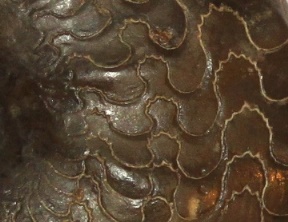
One of the easiest ways of recognizing Ceratites is the shape of the characteristic suture lines, which are found in all species of the genus, from the oldest to the most advanced, without any major change in phylogeny. What's more, Ceratites are systematically preserved in the form of an internal mold; the shell is never present, so the sutures are always visible.
Let's take a closer look at a few typical fossil species found in Lorraine:
- Ceratites evolutus owes its name to its highly evolved morphe with a very open umbilicus. Their size reaches or slightly exceeds ten centimeters. They can be found in large quantities, although preservation is generally of average quality.
- Ceratites spinosus owe their name to their strong costulation ending in a point (spino = thorn). The overall shape becomes thicker and larger, with a squarer belly. Their size generally ranges from 10 to 15 centimetres, but can reach 20 centimetres for the largest specimens.
- Ceratites enodis is a species with a distinctive morphology within the genus. They are perfectly smooth without costulation, whereas Ceratites posseckeri (sexual dimorphism) has lateral and ventral tubercles that become ribs as they approach the living quarters. Their size is smaller than in the previous species Ceratites spinosus, as the genus has undergone an evolutionary crisis. Ceratites enodis are among the least common in the Upper Muschelkalk, as the population has largely declined as a result of the crisis.
- Ceratites nodosus is the best-known species of the Upper Muschelkalk, because it is frequently encountered, but also because it is often confused with others, and several species were first described under this name before being renamed. The shape becomes relatively massive and thicker than older species, often with strong costulation. Their size is generally 15 to 20 centimetres, but can reach up to 30 centimetres.
- Ceratites (subgenus Discoceratites) semipartitus represent the most advanced species, but also the most extreme and largest morphe. They have very wide, flat flanks with no costulation, and an overall discoid shape with very little thickness (hence the name Discoceratites). The species Ceratites (Discoceratites) meissnerianus (sexual dimorphism) is very similar, but has slight costulation on the phragmocone. Their size can reach or even exceed 40 centimetres. The genus then becomes extinct at the top of the Upper Muschelkalk.

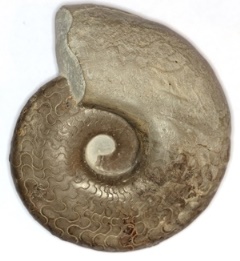
Spinosus Ceratites (12cm)
Edonis Ceratites(10 cm)

Semipartitus Ceratites (30 cm)
Nautiloids are represented only by the genus Germanonautilus. The predominant species, present in all levels, is Germanonautilus bidorsatus, whose size can easily exceed 20 centimetres. Two other species can be found, but their presence is more anecdotal. These are Germanonautilus tridorsatus and Germanonautilus suevicus (see our fossils for sale for more photos). The latter is characterized by tubercles running down each side of the belly. Often, only isolated living quarters are found, but the masticatory apparatus (Rhyncholites) or “beaks” of Nautilus can be more common.

Germanonautilus suevicus
Nautiloids fossils for sale here
Gastropods can be more or less common, depending on location and level. The most common species is Loxonema obsoletum, which can reach 10 centimetres in size. The shape is relatively elongated, with a dexterous curl. More rarely, we find the Undularia genus, similar in shape to Loxonema but with a more compact curl and more turns, or the smaller, wider and much stockier Neritaria genus (again, many photos in our fossils for sale).
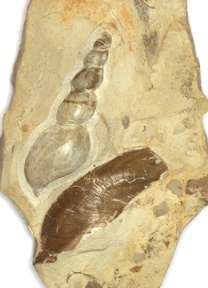
The most common bivalves are the Hoernesia socialis mussels. As their name suggests, they are often found in groups and grow to around 5 centimetres in size. Entolium discites and Pleuronectites laevigatus are also fairly common. Their general shape is broad and very rounded, and their size can exceed 10 centimeters. Plagiostoma striata have a more modest size and a strongly striated shell (hence their name). Myophoria, the ancestors of Trigonia, can grow to 10 centimeters and can also be found in groups, sometimes of several dozen individuals.
Association Loxonema obsoletum and Hoenesia socialise
Brachiopods are poorly represented, with almost exclusively the species Coenothyris vulgaris, whose fossils are often found in groups. Much more anecdotal are the inarticulate Brachiopodes of the genus Lingula. Other species are described (Tetractinella and Spiriferina), but only from the German Upper Muschelkalk.
Coenothyris vulgaris

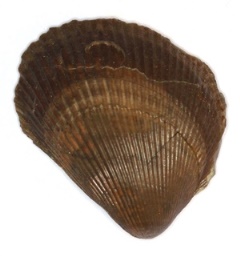
Lima striata
Echinoderms are also well represented.
The best known are the Crinoides Encrinus liliiformis, which can reach the respectable size of 1.5 meters with crowns of 10 to 15 centimeters. They are found only in the entrobic limestone that forms the basal levels of the Upper Muschelkalk. These Crinoids lived attached to the seabed in large colonies. The discovery of a complete crown is still uncommon in Lorraine. Nevertheless, you will find a selection of calyces in our fossil sales. Ophiuroids are represented by 3 species: Aspiduriella scutellata is distinguished by short, thick arms, while Aplocoma agassizi and Arenorbis squamosus have thinner, longer arms. Their size remains modest, in the centimetre range.
Very rare in the Upper Muschelkalk of Lorraine, the starfish Trichasteropsis weissmanni grows to around ten centimeters, with 5 relatively short arms and a stocky body. Regular sea urchins of the Cidaris genus alone remain extremely rare, although several species have been described.
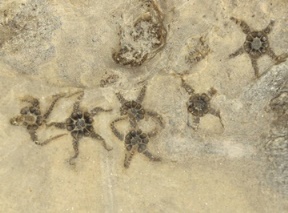

Aspiduriella scutellata group
Trichasteropsis weissmannitre
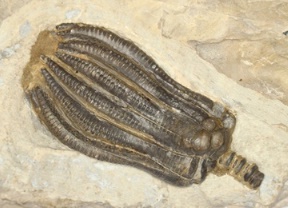
Encrinus liliiformis
The best-known crustaceans are the decapods Pemphix sueuri, which grow up to 10 centimetres long. They can be found in all levels, most often in nodules. Complete specimens are still a great find, but it is more common to find only cephalothoraxes, which are in fact exuviae, i.e. molts. Other genera have been described but are much rarer. These include Pseudopemphix, Lissocardia and Aspidogaster.
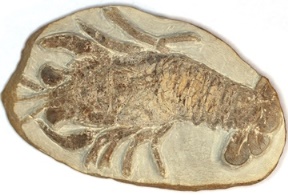
Pemphix sueuri
3 b. Vertebrates
Vertebrates are found in all levels of the Upper Muschelkalk. Their remains can be found in the form of nodules, but also in bonebeds, which can be very rich.
The emblematic marine reptiles of the Upper Muschelkalk are the Nothosaurus, hunting reptiles with elongated skulls and long, fine teeth. They lived on land and hunted marine fauna. It's not unusual to find vertebrae, ribs or teeth. The discovery of a skull or part of a skeleton is of course exceptional, but not impossible. There are 2 main species: Nothosaurus mirabilis and Nothosaurus giganteus. The latter could reach a respectable 3 meters in length.
Another well-known semi-aquatic reptile on this floor is Placodus gigas. It fed on the fauna of the seabed, mainly shellfish, crushing the shell with its broad, flat teeth that are easily recognizable and cannot be mistaken for any other. It was up to 2 meters long and had a stockier, less streamlined body than Nothosaurus, as it was not a hunter.
More rarely, it's possible to find the remains of Tanystropheus, a 5-6 metre-long aquatic reptile with a disproportionately long neck and very long cervical vertebrae.


Several species of Elasmobranchs (sharks and rays) are known from the Upper Muschelkalk.
Sharks of the Hybodus genus, whose descendants lived until the Upper Cretaceous, were hunters with fine, very sharp teeth that can be found quite easily in bonebeds. The dorsal prongs of these sharks can reach twenty centimetres in length and are edged with denticles.
Sharks of the Acrodus genus, on the other hand, were crushers, and their broad, flattened teeth are often found isolated, but more or less complete palates have already been discovered. Rays of the Palaeobates genus are also known for their flat, rectangular teeth



Fish were also an important part of the marine fauna. They are always preserved in nodules, and are therefore generally complete.
One example is the Colobodus genus, a crushing fish that could reach a size of almost 50 centimetres, sometimes with complete dental palates.
Another genus, Gyrolepis, could also reach a similar size. We also know of Saurichthys (carnivorous fish with very slender bodies), Cœlacanthes and Dipneustes of the species Ceratodus kaupii, whose characteristic dental palates are not very common.

Colobodus fish in its nodule
4: Conclusion
Contrary to certain preconceived ideas about the Upper Muschelkalk, we can see that the marine fauna is very varied (see the many fossils for sale on our site), even if Ceratites remain the best-known and most frequently found fossils. The species described above constitute a list that is far from exhaustive. Mixosauridae, Crocodilomorphs and Amphibians have also been described, but these remain very rare.
When it comes to identifying fossils from the Upper Muschelkalk, but also from the entire German Triassic from Buntsandstein to Keuper, the main reference is Martin Schmidt's book “Die Lebewelt unserer Trias”, written in German and first published in 1928. Although a number of species, particularly Ceratites, have been renamed and their number reduced, this book remains an indispensable foundation.
Numerous publications exist on the Upper Muschelkalk, almost all of them in German.
Finally, there are several possible methods for preparing Upper Muschelkalk fossils. The pneumatic pen remains the essential basic tool, but depending on the type of fossil, other tools or products may be useful. These include the sandblaster, mainly for finishing work, or potash (to be handled with great care) for fossils such as Echinoderms (Crinoids, Ophiuroids or Starfish). The use of a high-magnification binocular loupe for delicate work such as the umbilicus of Ceratites or the teeth of Hybodus is also a great help. See our article “How the fossils for sale on our site are prepared” for a concrete example of preparation.
